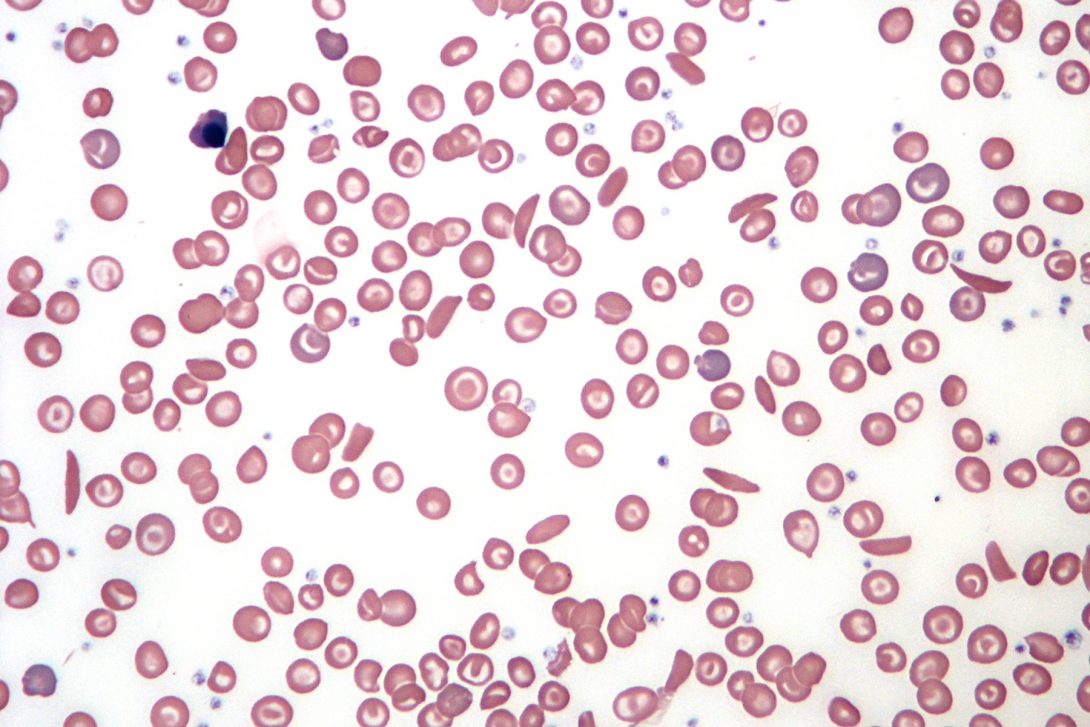


Results may be inaccurate if patient has received a blood transfusion within 3–4 mo before testing. Hemoglobin electrophoresis: Identifies any abnormal hemoglobin types and differentiates between sickle cell trait and sickle cell anemia.Sickle-turbidity tube test (Sickledex): Routine screening test that determines the presence of hemoglobin S (HbS) but does not differentiate between sickle cell anemia and trait.Stained RBC examination: Demonstrates partially or completely sickled, crescent-shaped cells anisocytosis poikilocytosis polychromasia target cells Howell-Jolly bodies basophilic stippling occasional nucleated RBCs (normoblasts).CBC: Reticulocytosis (count may vary from 30%–50%) leukocytosis (especially in vaso-occlusive crisis), with counts over 20,000 indicate infection, decreased Hb (5–10 g/dL) and total RBCs, elevated platelets, and a normal to elevated MCV.The patient with sickle cell anemia usually has the following laboratory results: The heart compensates for the decreased blood distribution by pumping more blood, and it may ultimately fail if it wears out. Blood flow is reduced to other body tissues including the kidneys, which may lead to renal failure. Due to the decrease in oxygen supply because of the sickling, stroke may occur. Patients with sickle cell anemia are unusually susceptible to infection, particularly pneumonia and osteomyelitis. The bone marrow expands in childhood in a compensatory effort to offset anemia, sometimes leading to enlargement of the bones of the face and skull.Ĭomplications of sickle cell anemia include: Dysrhythmias and heart failure may occur in adults. Jaundice is characteristic and usually obvious in the sclerae. Anemia is always present usually, hemoglobin values are 7 to 10g/dl. Symptoms of sickle cell anemia vary and are only somewhat based on the amount of HbS. Sequestration crisis results when other organs pool the sickled cells, just like the spleen.

Aplastic crisis results from infection with the human parvovirus. Tissue hypoxia and necrosis causes a type of sickle cell crisis called the sickle crisis. Cold can aggravate the sickling process, because vasoconstriction slows the blood flow. The causes of sickle cell anemia include: If the erythrocyte is again exposed to adequate amounts of oxygen before the membrane becomes too rigid, it can revert to normal shape. These long, rigid erythrocytes can adhere to the endothelium of small vessels when they adhere to each other, blood flow to a region or organ is reduced. The oxygen level in venous blood can be low enough to cause the erythrocyte to lose its round, pliable, biconcave disk shape. The sickle hemoglobin acquires a crystal-like formation when exposed to low oxygen tension. The HbS gene causes the hemoglobin molecule to be defective. Sickle cell anemia is the most severe form of sickle cell disease.The sickle hemoglobin (HbS) gene is inherited in people of African descent and to a lesser extent in people from the Middle East, the Mediterranean area, and the aboriginal tribes in India.Sickle cell anemia is a severe hemolytic anemia that results from inheritance of the sickle hemoglobin gene.Sickle cell anemia is an inherited form of hemolytic anemia.


 0 kommentar(er)
0 kommentar(er)
